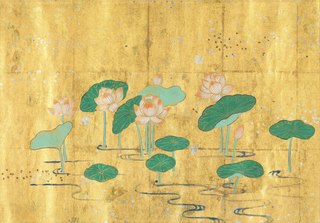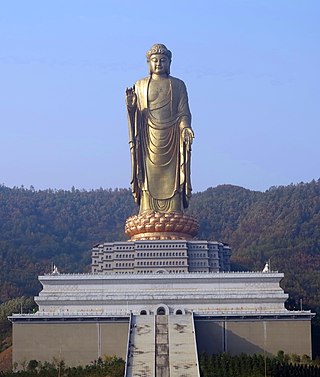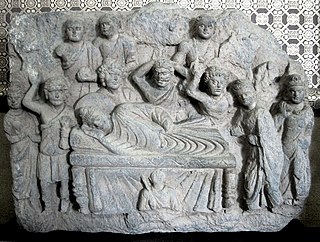Related Research Articles

Nichiren Buddhism, also known as Hokkeshū, is a branch of Mahayana Buddhism based on the teachings of the 13th-century Japanese Buddhist priest Nichiren (1222–1282) and is one of the Kamakura period schools. Its teachings derive from some 300–400 extant letters and treatises either authored by or attributed to Nichiren.

Tendai, also known as the Tendai Lotus School is a Mahāyāna Buddhist tradition officially established in Japan in 806 by the Japanese monk Saichō. The Tendai school, which has been based on Mount Hiei since its inception, rose to prominence during the Heian period (794-1185). It gradually eclipsed the powerful Hossō school and competed with the rival Shingon school to become the most influential sect at the Imperial court.

The Lotus Sūtra is one of the most influential and venerated Buddhist Mahāyāna sūtras. It is the main scripture on which the Tiantai, Tendai, Cheontae, and Nichiren schools of Buddhism were established. It is also influential for other East Asian Buddhist schools, such as Zen. According to the British Buddhologist Paul Williams, "For many Buddhists in East Asia since early times, the Lotus Sūtra contains the final teaching of Shakyamuni Buddha—complete and sufficient for salvation." The American Buddhologist Donald S. Lopez Jr. writes that the Lotus Sūtra "is arguably the most famous of all Buddhist texts," presenting "a radical re-vision of both the Buddhist path and of the person of the Buddha."
The dharmakāya is one of the three bodies (trikāya) of a buddha in Mahāyāna Buddhism. The dharmakāya constitutes the unmanifested, "inconceivable" (acintya) aspect of a buddha out of which buddhas arise and to which they return after their dissolution. Buddhas are manifestations of the dharmakāya called the nirmāṇakāya, "transformation body".
The Tathāgatagarbha sūtras are a group of Mahayana sutras that present the concept of the "womb" or "embryo" (garbha) of the tathāgata, the buddha. Every sentient being has the possibility to attain Buddhahood because of the tathāgatagarbha.

Vairocana is a cosmic buddha from Mahayana and Vajrayana Buddhism. Vairocana is often interpreted, in texts like the Avatamsaka Sutra, as the dharmakāya of the historical Gautama Buddha. In East Asian Buddhism, Vairocana is also seen as the embodiment of the Buddhist concept of śūnyatā. In the conception of the 5 Jinas of Mahayana and Vajrayana Buddhism, Vairocana is at the centre and is considered a Primordial Buddha.

In Buddhism, parinirvana is commonly used to refer to nirvana-after-death, which occurs upon the death of someone who has attained nirvana during their lifetime. It implies a release from Saṃsāra, karma and rebirth as well as the dissolution of the skandhas.

The schools of Buddhism are the various institutional and doctrinal divisions of Buddhism that have existed from ancient times up to the present. The classification and nature of various doctrinal, philosophical or cultural facets of the schools of Buddhism is vague and has been interpreted in many different ways, often due to the sheer number of different sects, subsects, movements, etc. that have made up or currently make up the whole of Buddhist traditions. The sectarian and conceptual divisions of Buddhist thought are part of the modern framework of Buddhist studies, as well as comparative religion in Asia.

Buddha-nature refers to several related Mahayana Buddhist terms, including tathata ("suchness") but most notably tathāgatagarbha and buddhadhātu. Tathāgatagarbha means "the womb" or "embryo" (garbha) of the "thus-gone" (tathāgata), or "containing a tathāgata", while buddhadhātu literally means "Buddha-realm" or "Buddha-substrate".
The Śrīmālādevī Siṃhanāda Sūtra is one of the main early Mahāyāna Buddhist texts belonging to the Tathāgatagarbha sūtras that teaches the doctrines of Buddha-nature and "One Vehicle" through the words of the Indian queen Śrīmālā. After its composition, this text became the primary scriptural advocate in India for the universal potentiality of Buddhahood.

The Mahāyāna Mahāparinirvāṇa Sūtra or Nirvana Sutra is Mahāyāna Buddhist sutra of the Buddha-nature genre. Its precise date of origin is uncertain, but its early form may have developed in or by the second century CE. The original Sanskrit text is not extant except for a small number of fragments, but it survives in Chinese and Tibetan translation.
Buddhist liturgy is a formalized service of veneration and worship performed within a Buddhist Sangha community in nearly every traditional denomination and sect in the Buddhist world. It is often done one or more times a day and can vary amongst the Theravada, Mahayana, and Vajrayana sects.

Gohonzon (御本尊) is a generic term for a venerated religious object in Japanese Buddhism. It may take the form of a scroll or statuary. The term gohonzon typically refers to the mainstream use of venerated objects within Nichiren Buddhism, referring to the calligraphic paper mandala inscribed by the 13th Japanese Buddhist priest Nichiren to which devotional chanting is directed.
Dharmadhatu (Sanskrit) is the 'dimension', 'realm' or 'sphere' (dhātu) of the Dharma or Absolute Reality.

The Three Ages of Buddhism, also known as the Three Ages of the Dharma, are three divisions of time following Shakyamuni Buddha's death and passing into Nirvana in East Asian Buddhism.
Purity is an important concept within much of Theravada and Mahayana Buddhism, although the implications of the resultant moral purification may be viewed differently in the varying traditions. The aim is to purify the personality of the Buddhist practitioner so that all moral and character defilements and defects are wiped away and nirvana can be obtained.

Kempon Hokke-shū (顕本法華宗) is a branch of Nichiren Buddhism based on the teachings of 13th-century Japanese monk Nichiren. It was founded by Nichijū in 1384. In Japan it has a membership of about 100,000 households and several lay members overseas. The international branch of Kempon Hokke Shu is currently headed by Rev. Sinyou Tsuchiya.

Mahāyāna is a term for a broad group of Buddhist traditions, texts, philosophies, and practices. Mahāyāna Buddhism developed in ancient India and is considered one of the three main existing branches of Buddhism, the other being Theravāda and Vajrayāna. Mahāyāna accepts the main scriptures and teachings of early Buddhism but also recognizes various doctrines and texts that are not accepted by Theravada Buddhism as original. These include the Mahāyāna sūtras and their emphasis on the bodhisattva path and Prajñāpāramitā. Vajrayāna or Mantra traditions are a subset of Mahāyāna which makes use of numerous tantric methods Vajrayānists consider to help achieve Buddhahood.

Prabhūtaratna, translated as Abundant Treasures or Many Treasures, is the Buddha who appears and verifies Shakyamuni's teachings in the Lotus Sutra and the Samantabhadra Meditation Sutra.
Bodhisattvas of the Earth, also sometimes referred to as "Bodhisattvas from the Underground," "Bodhisattvas Taught by the Original Buddha," or "earth bodhisattvas," are the infinite number of bodhisattvas who, in the 15th chapter of the Lotus Sutra, emerged from a fissure in the ground. This pivotal story of the Lotus Sutra takes place during the "Ceremony in the Air" which had commenced in the 11th chapter. Later, in the 21st chapter, Shakyamuni passes on to them the responsibility to keep and propagate the Lotus Sutra in the feared future era of the Latter Day of the Law.
References
- 1 2 3 4 Williams 2008, p. 157.
- ↑ Pye 1978, p. 50.
- 1 2 Xing 2005, p. 89.
- ↑ Fuss 1991, pp. 29–30.
- ↑ Leighton 2007, pp. 29–30.
- ↑ Buswell 2004, p. 473.
- 1 2 The English Buddhist Dictionary Committee 2009.
- ↑ Nichiren Daishonin, Rissho Ankoku Ron (Eng. On Establishing the Correct Teaching for the Peace of the Land), 1260 CE
- ↑ What is Pure Land Buddhism? da Sho-on Hattori, A Raft from The Other Shore Honen and the Way of Pure Land Buddhism, published by Jodo Shu Press
- ↑ Amida, who attained Buddhahood in the infinite past, / Full of compassion for foolish beings of the five defilements, / Took the form of Sakyamuni Buddha/ And appeared in Gaya. (Shinran, Hymnes of Pure Land, 88)
- ↑ "Varieties of Japanese Nembutsu". Archived from the original on 2017-09-24. Retrieved 2019-12-19.
- ↑ Richard Karl Payne, Kenneth Kazuo Tanaka (Editors); 'Approaching the Land of Bliss: Religious Praxis in the Cult of Amitåabha'; Studies in East Asian Buddhism, 17 (Book 17); Univ of Hawaii Pr; 1st edition (October 1, 2003); p.7
